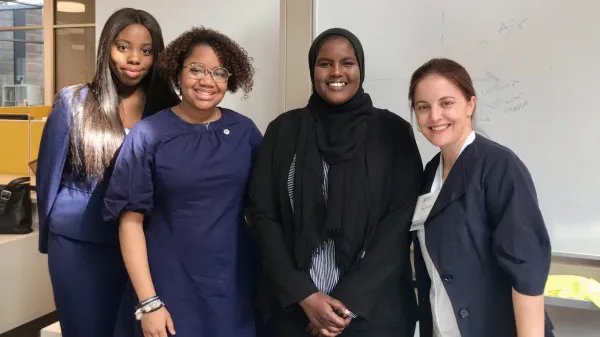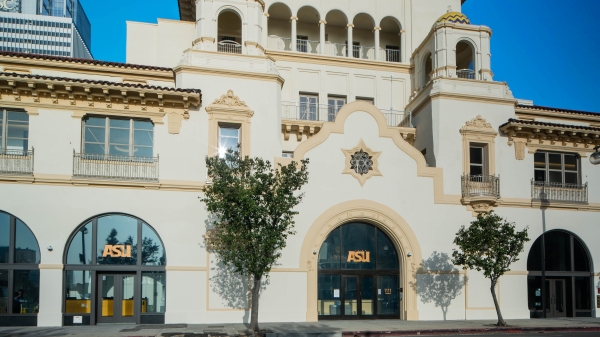Innovative ASU students play key role in Pulitzer-winning project

Okechi Apakama, Gregory Walsh and Brendan Walker were among the students that played an important role in “The Wall,” which featured video footage of every foot of the 2,000-mile U.S.-Mexico border.
Arizona State University students at the Walter Cronkite School of Journalism and Mass Communication were part of a groundbreaking USA Today Network project that has won the 2018 Pulitzer Prize in Explanatory Reporting.
Cronkite students played an important role in “The Wall,” a USA Today Network project, which featured video footage of every foot of the 2,000-mile U.S.-Mexico border. The unprecedented project, published on Sept. 22, 2017, on azcentral.com and USA Today, allows users to travel the border virtually, viewing barriers, examining topography and learning about the people who live in the border region.
Nicole Carroll, a 1991 graduate of the Cronkite School and a member of the school’s Alumni Hall of Fame, led the project as vice president of news and executive editor of The Arizona Republic/azcentral.com, which is part of the USA Today Network. In February, she was promoted to editor in chief of USA Today.
Cronkite School Dean Christopher Callahan said the project exemplifies the quality journalism produced by Cronkite alumni and students.
“We sincerely appreciate our partnership with the USA Today Network and The Arizona Republic and congratulate all of the journalists who worked on this outstanding project,” he said. “For our students to be a part of a Pulitzer Prize-winning project is a fantastic illustration of what makes the Cronkite School such a special place.”
To create the map, the Cronkite students Okechi Apakama, Brendan Walker and Gregory Walsh worked with Shea Lemar, geographic information system project manager at ASU’s School of Geographical Sciences and Urban Planning, utilizing aerial footage from a helicopter. The students combed through the video, linking every second to its location on the map.
Walsh said the project, which involved reviewing 20-plus hours of footage multiple times, took 12 weeks to complete. He said it was inspiring to work on the project, which helped people to experience the entire U.S.-Mexico border in a new way.
“I’m really honored that our team was a part of this special project,” Walsh said. “I’m just really excited and proud of the work that we all did.”
Cronkite students Nicole Gimpl, Robert Gundran and Ryan Santistevan also worked on the project, providing key research. Santistevan was a Pulliam Fellow at The Arizona Republic and worked with reporter Daniel González on a story that looked into migrants who died during the treacherous journey crossing the Sonoran Desert.
“Working on this project was an amazing experience because I want to become an investigative border reporter,” Santistevan said. “And to be in the newsroom today and hear that we won was so incredible. It was so surreal to be a part of that today.”
In all, the Pulitzer Prize-winning project included the work of 30 reporters and photographers at The Arizona Republic who interviewed migrants, farmers, families, tribal members — even a human smuggler. They joined Border Patrol agents on the ground, in a tunnel, at sea. They also scoured government maps and fought for property records.
Mi-Ai Parrish, the Cronkite School’s Sue Clark-Johnson Professor in Media Innovation and Leadership, was president and publisher of The Arizona Republic during the project. She said “The Wall” broke new ground in coverage of the U.S-Mexico border.
“The Arizona Republic and the Walter Cronkite School teamed up to produce inspiring, innovative digital journalism that helped educate a nation,” Parrish said. “I’m proud of the work, the tremendous people and the figure-it-out-together spirit that is a hallmark of both organizations. These kinds of partnerships will enable quality journalism to flourish for our communities.”
Also, in the 2018 Pulitzer Prizes, The Cincinnati Enquirer, also part of the USA Today Network, won the Pulitzer for Local Reporting for a series on heroin addiction. The project was led by Peter Bhatia, former editor and vice President of The Cincinnati Enquirer and Cincinnati.com who previously taught at the Cronkite School as the Edith Kinney Gaylord Visiting Professor of Ethics. He is now the editor at the Detroit Free Press.
More Law, journalism and politics

School of Politics and Global Studies director's new book explores mass violence
Why do people commit atrocities and why are certain groups, including religious and ethnic, more vulnerable to large-scale…

ASU faculty contributing to improvement of Wikipedia
Many academics have a love-hate relationship with Wikipedia. While the website has information about almost anything you can…

ASU Law students gain vital experience through Los Angeles location
Students at the Sandra Day O’Connor College of Law at Arizona State University may be concentrated in the school’s downtown…